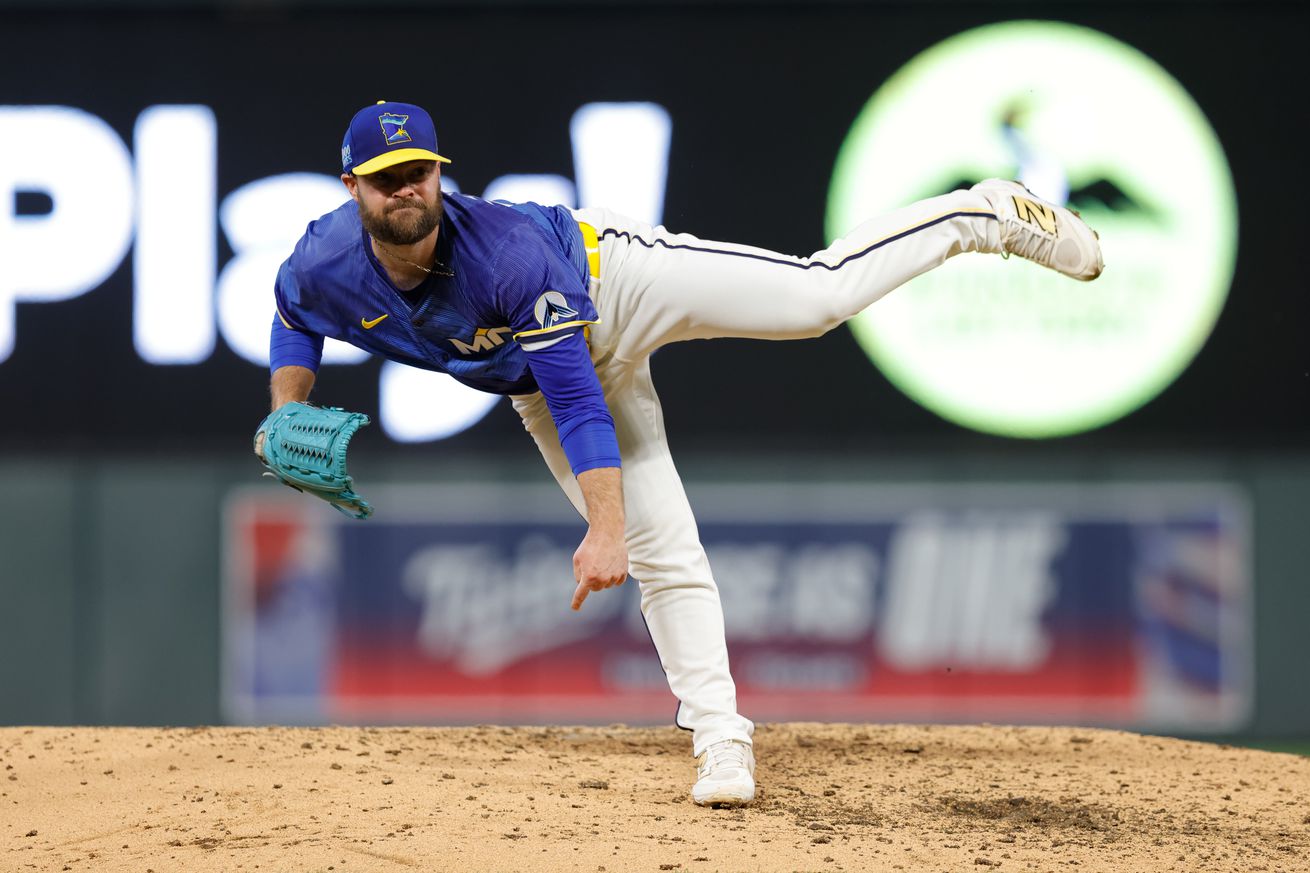
The deceptive lefty has been one of the Twins’ best relief arms thanks to a well-crafted arsenal that fits together beautifully.
Before the Twins’ current six-game winning streak, the bulk of the blame for their slow start was rightfully directed towards an offense that routinely forced the pitching staff into situations with little margin for error. That’s been especially hard on their corps of relievers, who have the majors’ second-most losses (11) and rank 24th in win probability added (which is up from 29th thanks to this week’s winning streak) through games on May 9.
It’s difficult to give the bullpen a pass for their role in those disappointments, but other numbers suggest they’ve largely done some good work. Minnesota’s relievers rank 5th overall in fielding independent pitching (3.28), fourth in fWAR (1.8), and third in strikeout-to-walk rate (26.1%: 7.6%), which is one of our best predictors of success.
One of the brightest spots in the Twins’ bullpen has been lefty Danny Coulombe, who has yet to allow a run in 17 appearances, while sporting a sterling 17-1 strikeout to walk ratio. Coulombe, who returned to the Twins on a one-year, $3-million deal this past winter, picked up his second save of the season in Jhoan Duran’s stead last night.

Photo by Scott Winters/Icon Sportswire via Getty Images
Coulombe’s success in the early part of 2025 shouldn’t be a surprise. Over the previous four seasons, he posted a 2.75 ERA, 3.17 FIP, and 132-33 strikeout-to-walk ratio over 133 appearances. He’s been a solid middle and matchup reliever for a long time.
He also isn’t like many of his teammates on the mound. The Twins have built a pen of big guys throwing power stuff from the right side. Coulombe has usually been the only left-hander in the Twins’ bullpen, and he goes about his business in a very different way.
As a group, Minnesota’s relievers average better than 96 mph on their fastballs, the 4th-highest average in MLB. Of course, it helps to have Jhoan Duran and his frequent triple-digit heaters bringing up that number, but Louis Varland, Griffin Jax, and Jorge Alcala are all besting that team average, too, and Brock Stewart isn’t far behind.
Coulombe, on the other hand, is 5’10 and sits about 90 mph with his fastball. What Coulombe lacks in velocity, he has more than made up for with deception and atypical movement.
A Carefully Crafted Arsenal
Coulombe is the type of pitcher you might call a tinkerer. The chart of his pitch mix over time from Statcast is an adventure:
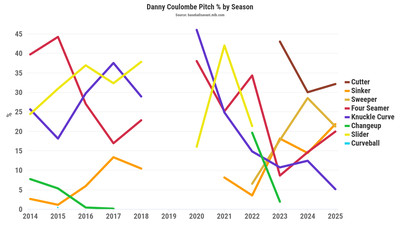
From Baseball Savant
That isn’t meant to say that there wasn’t a thoughtful method behind the seemingly constant tweaking. Coulombe, who told FanGraphs’ David Laurila back in 2022 that he’s always had a feel for spin and manipulating the baseball, just went through lots of trial and error to find an arsenal that was more than the sum of its physical inputs.
When Coulombe was with the Twins previously (2020-2022), he mostly operated with a three-pitch mix – four-seamer, slider, and curveball, while occasionally dabbling with a sinker, a changeup (in 2022), and a larger breaking sweeping slider.
He put up good results for the Twins (2.92 ERA in 41 appearances) but outperformed his peripherals thanks to a strikeout rate that left a little to be desired (22.0%) and too many walks (9.3%).
Upon landing with Baltimore via trade late in Spring Training 2023, he picked up a cutter that quickly became his most often used pitch and the final piece to the puzzle. With the cutter in play, he leaned more on the sinker, de-prioritized his curveball, and ditched the changeup entirely.
The last two seasons, Coulombe has settled in on a cutter, sweeper, sinker, four-seamer arsenal, each thrown 20-30% of the time, with the occasional knucklecurveball mixed in.
We can understand why that was the mix Coulombe landed on by looking at the movement profiles of his pitches:
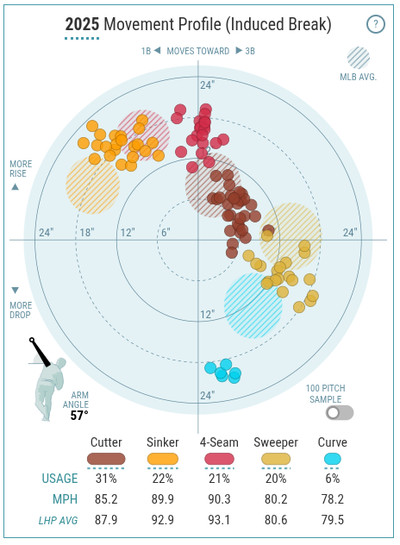
From Baseball Savant
I’ve written about the advantages of having multiple pitches that look like each other on their way to the plate. It makes it difficult for the hitters to identify what’s coming and get the barrel on it.
Looking at Coulombe’s movement profile above, you can see that his sinker, four-seamer, cutter, and sweeper make almost one contiguous plot across the top of that visual, and his curveball is nearly perfectly in line (vertically) with his four-seamer and cutter.
Like puzzle pieces, everything fits together beautifully, which enables a high degree of deception. This deception creates uncertainty for hitters and allows everything in his arsenal to play up above the raw, physical characteristics of the pitches.
With this mix as his weaponry since the 2023 season, Coulombe’s strikeout rate has popped up to 28.5%, and he’s nearly halved his walk rate to 4.9%, while posting a 2.17 ERA across 110 appearances. Much of that gain is attributable to this pitch mix, especially the cutter and sinker, enabling him to snag more called strikes (13.5% with 2020-2022, 17.9% since).
Having that many options also allows Coulombe to be more than just a lefty-matchup reliever. While he’s a bit stronger against lefty hitters, he’s also performed well against batters on the right side of the plate, holding them to .215 wOBA last year and .174 so far in 2025.
Atypical Movement
Taking advantage of tunnel effects isn’t the only way Coulombe utilizes deception. He’s also got a mix of pitches that move in ways that are contrary to usual expectations.
I’m about to show you several pitch movement plots that compare how Coulombe’s pitches move to how other lefties’ pitches move. These are from the perspective of the pitcher looking at home plate, the X axis is horizontal movement, and the Y axis is induced vertical break, which is a measurement of movement without the effects of gravity.
Cutter
Coulombe’s most utilized pitch this season and last has been his cutter, a ~85 mph offering with significant horizontal and vertical movement. You can see in the plot below that his cutter has a unique combination of vertical and horizontal movement:
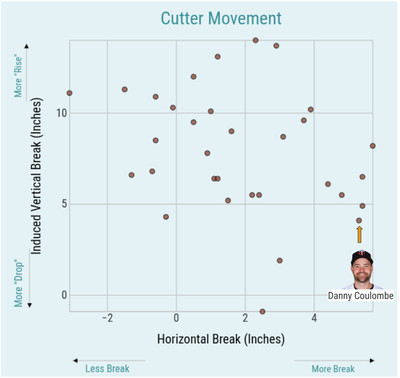
From Baseball Savant
With that shape, this pitch probably could be thought of as a tight slider. He deploys it at about equal rates to right-handed and left-handed hitters (about a third of the time) and most often targets it low and inside to righties and low and away to lefties:
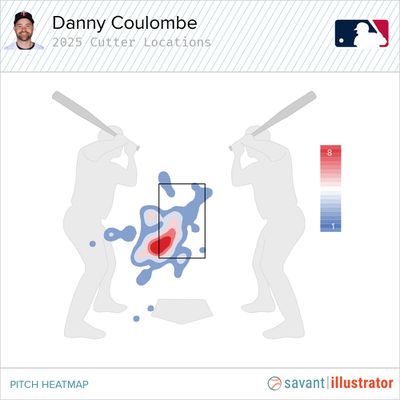
From Baseball Savant
Since its introduction in 2023, Coulombe’s cutter has been the 3rd-most valuable lefty cutter (among both starters and relievers) by Statcast run value in MLB.
Sinker
Next most utilized is his sinker, a 90 mph moving fastball that Coulombe uses most often for left-handed opponents. Now, when you see “sinker,” you might be visualizing a pitch that moves downward and is used low in the zone to create weak contact on the ground.
That’s not what Coulombe’s “sinker” is.
It’s a two-seam fastball that gets significantly less downward and horizontal movement than other sinkers (remember these plots are from the pitcher’s perspective):
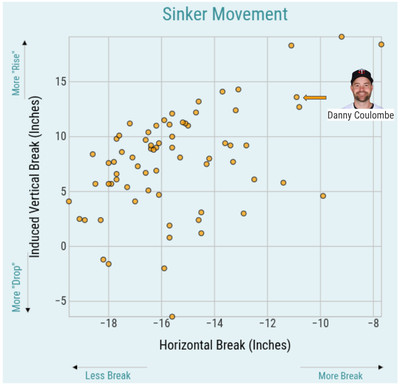
From Baseball Savant
With that movement profile, this pitch just doesn’t do what batters expect it to do. It stays up and runs less than expected. That makes it a pitch that plays best up in the zone, which is counterintuitive for a “sinker.”
You might think of it a bit like Joe Ryan’s four-seamer in that it’s a pitch that gets more “rise” than you’d expect, so batters tend to swing under it. Coulombe leans into this pitch’s unusual shape by often throwing it up and to his glove side (i.e., away from lefties) where it can stay above hitters’ barrels.
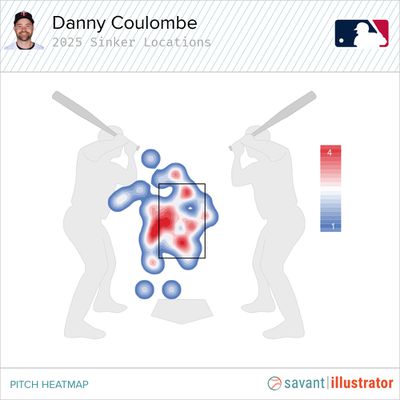
From Baseball Savant
Opposing hitters have produced a .123 wOBA against Coulombe’s sinker since 2023, the lowest mark among all left-handed pitchers in MLB.
Four-Seamer
Perhaps the pitch that enables the sinker and cutter to be as effective as they are is Coulombe’s four-seamer, a nearly perfectly straight 90-mph offering (5th-percentile velocity).
Coulombe has added about an inch more induced vertical movement to his four-seamer since returning to the Twins, something the club has proven to be adept at training, see Pablo Lopez, among others, but it’s still below average in that regard. What stands out is its lack of horizontal movement:

From Baseball Savant
We think of four-seamers as straight pitches, but in reality, nearly all four-seamers have some horizontal movement to the arm side because very few humans throw perfectly overhand.
Coulombe operates from a high arm angle (57°) and can release his four-seamer with almost perfect backspin. That results in the pitch having no horizontal movement. You might think that could be a bad thing (i.e., straight pitches get hit), but consider how that lack of movement makes the pitch different from other four-seamers. Look at the plot above. Hitters have learned to expect some arm-side run, and Coulombe’s four-seamer just doesn’t do that.
The pitch serves an important role in connecting the sinker and cutter, but is also effective in its own right. Last year, opponents produced .214 wOBA against it, and the pitch has a 31.6% whiff rate so far this season.
Breaking Balls
By now, I hope you’ve noticed that Coulombe’s pitches are all on the edges of these pitch movement plots. It’s the same for his two breaking balls — a sweeper that doesn’t sweep as much as most but has more vertical movement, and a vertical breaking curveball that can be described in the same way:
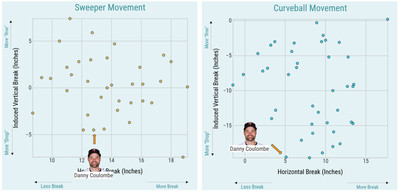
From Baseball Savant
Coulombe uses his sweeper about 20%, and more often to right-handers than left. The curveball is used sparingly, just 10 times all season so far, primarily as a below-the-zone for chase breaking ball. Again, going back to 2023, Coulombe’s sweeper is 6th among left-handers in run value, and he’s held opponents to .190 wOBA against it.
— — — — —
Taken together, Coulombe has developed a well-rounded arsenal that makes maximal use of deception and unexpected movement. If you were wondering how a guy who sometimes doesn’t crack 90 mph can be so effective, that’s the major reason why.
John writes for Twinkie Town, Twins Daily, and Pitcher List, with an emphasis on analysis. He is a lifelong Twins fan and former college pitcher.
